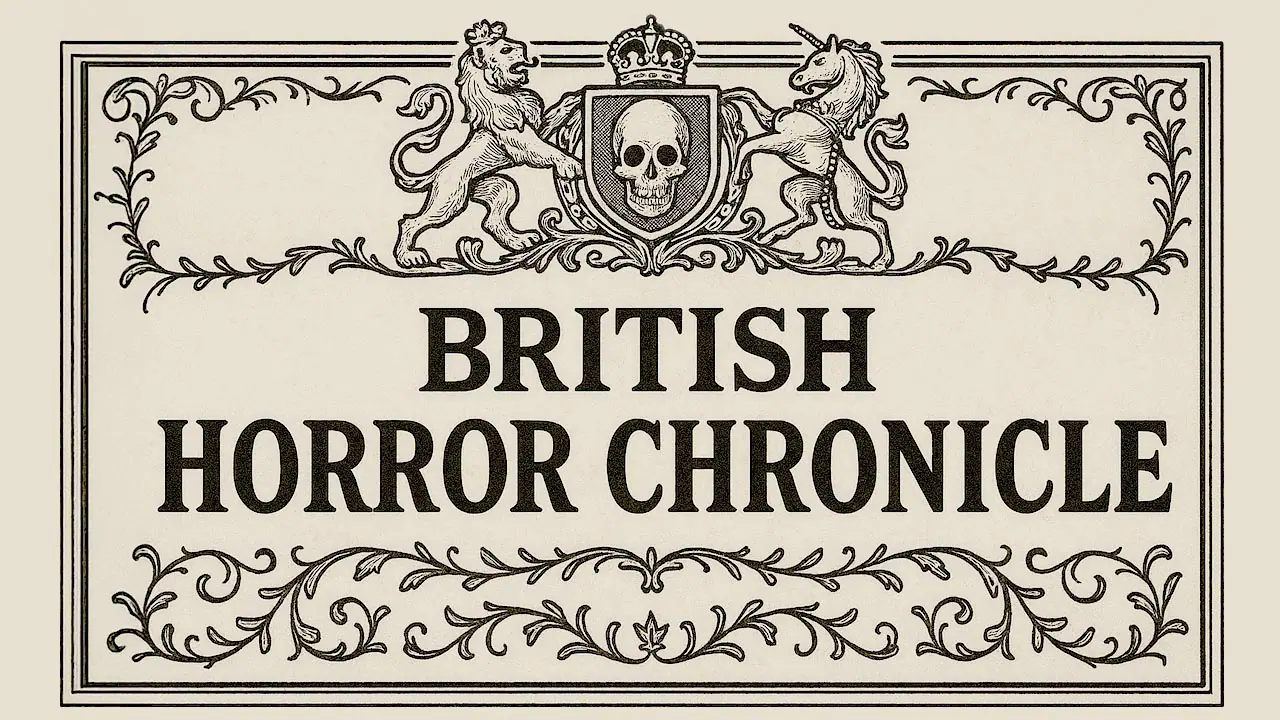The British Horror Chronicle
Friday Edition
Established 1946 — In the Service of British Cinematic Letters
A Crown of Terror: Hex Studios Unveils Its Most Ambitious Fantasy Yet
By Our Special Correspondent
Independent genre cinema in the United Kingdom finds itself in the firm grip of revitalisation, thanks to the redoubtable efforts of Hex Studios. Under the leadership of Mr. Lawrie Brewster, the studio has presented what many are calling its magnum opus: The Reign of Queen Ginnarra, a formidable tale of medieval horror filmed entirely in the ancient Scottish towns of Kirkcaldy and Dunfermline.
The motion picture, which spans a most generous two and a half hours, introduces audiences to the fictional kingdom of Aberon. Here, Queen Ginnarra, a figure not unlike Gloriana herself, rules with equal parts majesty and menace, her authority shadowed by blood, betrayal and prophecy. Having ascended the throne through patricide, she finds her reign imperilled by the escape of her younger brother, Elderon. The Queen, ever suspicious, dispatches her son and the eldritch entities known only as the Old Ones to hunt him through the wastelands.
Meanwhile, Elderon, haunted by shame and exile, finds sanctuary among the remnants of the old guard. His path, though uncertain, may yet lead to rebellion, redemption, and a final reckoning with his sister.
A Homage to Britain’s Fantastical Legacy
The film is steeped in influences from British cinematic triumphs such as Mr. John Boorman’s Excalibur and the BBC’s I, Claudius, both notable for their operatic storytelling and rich political intrigue. Mr. Brewster has taken such inspirations and interwoven them with the Lovecraftian dread and ornate aesthetics reminiscent of Hammer and Amicus, studios whose very shadows inform every corner of Queen Ginnarra‘s darkened halls.
As Mr. Brewster explains, “We aimed to craft something timeless, unbound by fleeting trends. Our eyes were fixed on Romantic Cinema, where grand tales were told without cynicism.”
This commitment bore fruit through painstaking production. More than one hundred artists, costumiers, set builders and historians collaborated to construct markets, cultic temples and royal courts with surprising splendour.
The Queen and Her Court
At the centre of this regal affair stands Miss Megan Tremethick in the titular role. Her Queen Ginnarra is every inch the haunted monarch: imperious, inscrutable and chilling. Miss Tremethick, known in creative circles as a pioneering filmmaker, brings a studied stillness to the part, informed by Tudor queens and tales of Countess Báthory.
Joining her is Mr. Andrew Gourlay as Elderon, stoic yet sympathetic. Mr. Dorian Ashbourne, a rising Scottish talent, portrays a gleefully cruel agent of chaos; Mr. Novarro Ramon intrigues as a shadowy manipulator; and Mr. Sam Barclay offers spiritual gravitas as the monk Elias.
Also notable are performances by Mr. Chris Capaldi as a world-weary Duke, Mr. Stephen Corrall as a duplicitous councillor, and long-time Hex collaborators Mr. Stephen Kerr and Mr. Michael Daviot as militaristic and ecclesiastical villains, respectively.
Filming at Dunfermline Abbey lent an air of solemn authenticity. Founded in the year of Our Lord 1128, the Abbey granted the production a majestic sanctity, respected throughout the shoot. According to Mr. Brewster, the sight of his actors processing through the high street in full regalia astonished the townsfolk.
On-Set Happenings: Misadventure and Merriment
Though the film is grave in theme, the production was not without levity. Mr. Sam Barclay, costumed as a monk, was once chased through the forest by a stray ram, his dignity spared only by a well-placed branch. Mr. Stephen Kerr, committed to his craft, was accidentally left tied to a mast between takes, forgotten amidst the call for sausage rolls.
Mr. Brewster reflected, “At times, directing this felt like leading a medieval army albeit one that required regular tea breaks.”
A Regal Reception
The film debuted at the Romford Horror Film Festival, receiving accolades from critics and audiences alike. Nerdly described it as “a brilliant blend of medieval fantasy and Lovecraftian horror,” while Bloody Flicks praised its sombre grandeur. Esteemed critic Mr. Anton Bitel commended its marriage of folklore, theology, and terror.
Mr. Brewster notes, “There were tears in the audience. It proves that independent film, even when modest in resources, may yet stir the soul.”
A Movement Begins
The film shall be made available to the public via digital release through The British Horror Studio’s official Patreon and in a Blu-ray edition through Hex Studios’ shop at the end of April.
More than a film, The Reign of Queen Ginnarra represents a declaration of intent. As Mr. Brewster affirms, “We believe the future of British horror lies not with corporations, but with creators, communities, and conviction.”
With Amicus Productions soon to return in In the Grip of Terror, featuring Miss Jane Merrow and Mr. Laurence R. Harvey, it seems this new era of independent horror is just beginning.
For further details or to join the movement, readers are invited to visit www.hexmedia.shop or the official British Horror Studio Patreon.
Mr. Brewster further discusses the start of his career, and offers his reflections on the current state of film distribution, and informs readers where they may obtain his earlier work, The Slave and the Sorcerer.
A Note on the Author
Mr. Lawrie Alyn Brewster is a Scottish filmmaker of considerable standing, known for his atmospheric horror pictures and tireless advocacy for independent production. He presides over Amicus Productions and directs the operations of Hex Studios and The British Horror Studio.
He has recently published an editorial entitled Lawrie Brewster’s 5 Brutally Honest Tips for Indie Filmmaking Success, which drew great admiration, and no small number of reposts, upon the Reddit platform.
Readers may peruse further writings and reflections by Mr. Brewster at his official Internet residence:
www.lawriebrewster.com
Mr. Brewster further discusses his latest motion picture, The Reign of Queen Ginnarra, offers his reflections on the current state of film distribution, and informs readers where they may obtain his earlier work, The Slave and the Sorcerer.
For a modern interpretation, readers are directed to Mr. Lawrie Brewster’s companion article in Amicus Horror.


